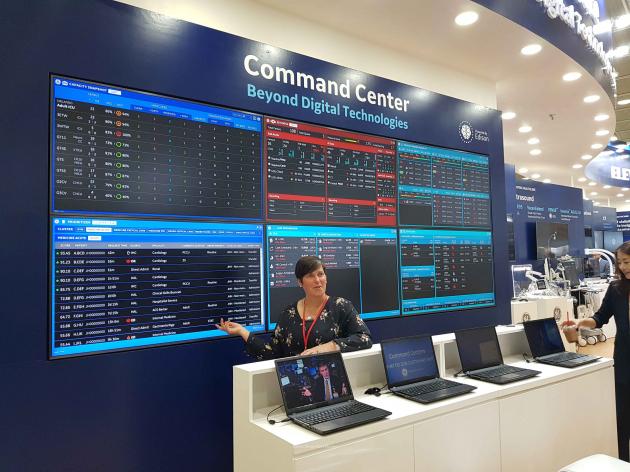As populations are aging globally, especially among developed nations, hospitals in the world are facing new challenges, including insufficient bed capacity, mounting costs, complex regulation and technology overload. That explains why it has recently become essential to improve the quality of medical service with sustainable hospital management and increased efficiency through the effective use of medical technology.

GE Healthcare believes that its “Healthcare Command Center” can resolve most of the issues that hospitals face daily.
Seven hospitals in the U.S., UK, and Canada, including the Johns Hopkins Hospital, have adopted GE Healthcare’s command center solution. The company believes that local hospitals can benefit significantly with the installation of its command center.
The command center uses complex algorithms, and predictive analytics to target improved clinical, operational, and patient outcomes.
In general, the healthcare command center provides a team of people using artificial intelligence around the clock to support the optimal delivery of patient care, hubs to monitor performance and learn and launch improvement programs and focal points for transparent, integrated culture.
Korea Biomedical Review met with two GE Healthcare managers on Thursday to learn more about its command center and how the installation of such a center can benefit Korean hospitals.
The two executives are Kerrie Hauge, managing director at GE Healthcare, and Jang Kwang-hee, chief growth officer at GE Healthcare Korea’s Growth and Strategy Division.

KBR: What role does the GE Healthcare’s Command Center play in the hospital?
Hauge: The command center serves as a central hub for learning and innovation. It also provides a system’s view on what is happening in the hospital and an opportunity to coordinate activities that help with patient safety and quality as well as the workflow, decision making and improving operations.
KBR: What are the improvements made by hospitals that have implemented the command center?
Hauge: Many of them have reduced waiting times for patients coming from all portals of entry such as emergency departments and surgery as well as those waiting to be transferred from other hospitals.
The command center has also helped hospitals reduce the excess bed days and waiting times for key services such as MRIs and lab services.
Notably, the center has improved the ability of the hospital to operate efficiently at high occupancy rates. This is important to congested hospitals, as they cannot expand the number of beds overnight and maybe forced to run at a high-occupancy for a long time.
In detail, hospitals reported that wait times for beds in emergency rooms fell by 25 percent, the excess bed days, by 52 percent, and fulfillment time for patient care requests, by 38 percent. The hospitals also reported they were cleaning up hospital beds 45 percent faster than before.
Jang: Large university hospitals have a high level of service, and because of that, they are very focused on serving acute patients and want to treat as many acute patients as possible so they can fully utilize all of their capabilities. The command center can help them achieve such goals.
KBR: When can Korean hospitals expect from installing the GE Healthcare command center?
Jang: Our company is very interested in working with hospitals to install the systems, but we cannot provide a specific date as we have just set up the command center business in Korea.
However, we’ve seen much interest from local hospitals, and we have been conducting meetings with them.
Hauge: I visited several countries recently regarding the launch of the command center, and I would say the interest and level of engagement in Korea are relatively very high compared to other countries.
KBR: Major university hospitals in Korea operate several branch institutions. Does this mean that all branches hospitals have to install the GE Healthcare command center?
Hauge: Most customers choose to install the command center at every branch due to issues that may arise locally. However, they are not required to install the command center to derive benefit.
Our customers have chosen to have a central hub, a large command center, and a small satellite command center at each of their branches.
GE Healthcare also considers the ability of the hospital to accept change. This is because if the company introduce its system all at once, it’s tough to absorb all the changes made. Therefore, the company tries to make that change gradually so that the command center can have a sustainable impact.
KBR: Are the hospitals required to install a fully-scaled command center from the start?
Hauge: No, they can start with a specific area or department, and if they like what they see, they can expand the system to the entire hospital. The command center hub engine, which brings all of the data together, is very scalable. Therefore, it is possible to install the engine and start with just a couple of our company’s specific applications. Afterward, since we have had time to develop a relationship with the hospital, it is relatively easy to expand if the hospital chooses too. We want to start with the most challenging problem that the hospital faces.
GE Healthcare always works the problem back from the source, which means that the company does not just hand out its catalog and make the hospitals choose. The company works very closely with the client to understand what challenges they are facing and apply analytics and modeling at the beginning stage to help them quantify where their opportunity areas are and build the command center to address those issues.
That shows why the command center has achieved such a high return on investments for our clients.
KBR: How long does it take for hospitals to see a return of investment for the command center?
Hauge: That depends on what problems the hospital wants to address, but the company tries to target a return of investment of about three years. However, most of our clients have seen a return of investment at an earlier stage.
Clients have also said that while the return of investment was terrific, the intangible benefits have been even more noticeable such as the ability to break down the departments and work together.
KBR: Privacy is a vital issue in Korea. How does the command center protect personal medical information for misuse?
Hauge: Our company is meticulous in protecting personal medical information. As every country has different privacy laws, we work very closely with each hospital's privacy officer to comply with all the local privacy laws.
The command center system also carefully selects staffs that can access the system, and the information is only provided to staff with a need to know and compliance with privacy laws.
The system also masks names or anything that can identify a patient where appropriate and is careful about where the information is being displayed.
Jang: We also provide different storage methods that fit the regulation of a specific country. Hospitals can choose either to store the data on-site or on a cloud server.

